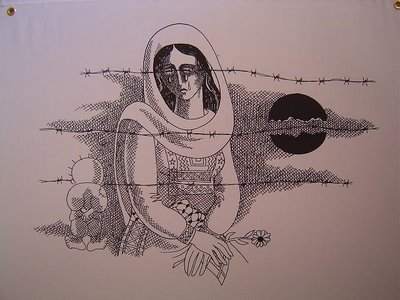
Ali al Naji's cartoon of the Palestinian refugee behind barbed wire seems appropriate when thinking of Jayyous and Qalqilya, both cities behind fences.
I had the honor of suffering a "hardship" at the hands of Israeli soldiers when they refused to let me pass through the agricultural gate in the separation barrier. If they had allowed me, I would have walked up the hill to Jayyous in 10 minutes. Instead, I had to turn back and instead took a ride on Shareef's tractor to a settler road that skirts the edges of Jayyous's land along the 1948 border, and entered Israel on foot. Incidentally, all of Jayyous's land is freely accessible from Israel, but not from Jayyous. No fence, no checkpoint, nothing.
The Apartheid Wall Encloses the City of Qalqilya
CLICK IMAGES TO ENLARGE
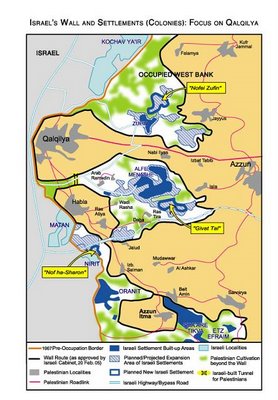
This map shows the dramatic route of the separation barrier around the Palestinian city of Qalqilya. The barrier is a concrete wall around the city, cutting it off from it's land and surrounding villages. The wall runs along the 1948 border on the westernmost side, and then cuts into the west bank to sieze land for settlements near Jayyous, in the north, and Hable, in the south.
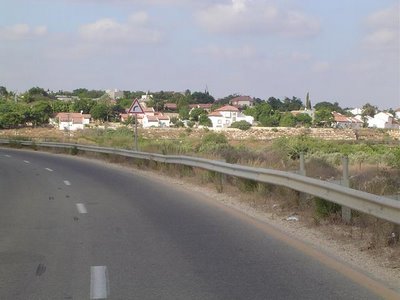
I felt fortunate to have the opportunity to walk between worlds as I made my way into Israel from Jayyous' land. This Israeli town [ABOVE] runs directly to Jayyous' land, but it does not cross the 1948 border so it is not technically a settlement. But what's the difference to the people of Jayyous who lost their land when this town was built? Just an example of how even beyond the occupation, Israel's racist nature as a state that puts the rights of one ethnic group over all others, will eventually have to be confronted if there is to be peace.
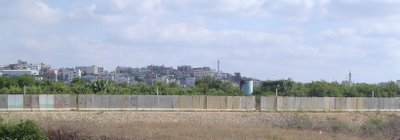
[ABOVE] Qalqulya behind the wall
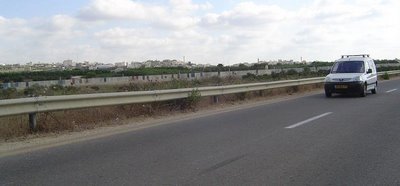
It's not like they don't know...
Tens of thousands of Israelis pass by the wall every day on a major highway. These photos are from a less-travaelled settler road. The wall is visually dramatic and horrifying, replete with barbed wire and sniper towers, but most Israeli's support it as a measure "against terrorism."
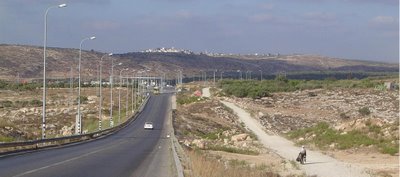
Click this photo!
TWO WORLDS IN ONE PLACE
After looping around Qalqilya in an Israeli taxi,I get out and walk back into the West Bank. While there is a change in reality between Israel and the West Bank, you can say that Israel has extended, or overlayed itself into the West Bank, creating separate Israeli and Palestinian realities in one place. It's a situation of almost total segregation, and it exists to the benefit of Jewish Israeli settlers and to the detriment of native Palestinians.
For example this modern, wide and well-lit highway pictured above is reserved for cars with Israeli plates on their way to Jewish only settlements. Palestinian taxis with special permits are also allowed, but no private Palestinian vehicles. In this photo, to the right you see a Palestinian woman walking on a dirt road. Under the "apartheid road regime," Palestinians are forced to spend most of their time travelling on agricultural roads, often dirt, poorly paved, or just one lane for two way traffic. Some Palestinian taxis can drive on some Israeli settler roads, but they have to have special permission. Meanwhile, with Israeli plates, you can zip around the West Bank on modern highways and never even realize you've left Israel.
In the photo above: Ahead on the hilltop you see the village of Jayyous. I was dumbstruck when I realized, from this vantagepoint the overwhelming scale of the settler project. I know the statistics: 400,000 settlers in the West Bank among 2 million Palestinians. Settlers take nearly half of the land, most of the water, all of the good roads, etc. But in a a place like this where the settlers totally dominate, you realize the true peril that Palestinian towns and villages are in. They are being cast aside, or better put, they are like shrinking islands of indiginous people, diminishing daily in a sea of modern, consumption-driven, Jewish settlements. How can there really be any hope for a Palestinian state now that the West Bank is full of Israeli settlers?
Most of the settlers in this area commute to Tel Aviv and other Israeli urban areas in just minutes and work in regular jobs. As they passed in their cars, some seemed to marvel at me walking down the road with my backpack. One person gestured at me, shrugging his shoulders "What gives? Are you crazy?" I wonder if the Palestinians who's land they live on even enter their minds in any way other than a security problem on the road to work.
But, feeling alone, I start to wonder, am I crazy to walk down a road where "an Arab" could abduct me, thinking I'm a settler? The realities clash in my head until I flag a Palestinian taxi and jump in... and within minutes, the driver is treating me like an old friend or long lost relative. Not because I'm especially good with people, it's just that most Palestinians love anyone who comes to visit them. (even Israelis -- that is, if they're not wearing military uniforms, and if they come as respectful guests rather than enterprising settlers). Oppression, isolation, and exclusion seem to have magnified traditional Arab hospitality here. Outsiders make friends fast, and become like family in hours. In the worst-hit areas, the intensity of frienships and hospitality is matched only by anger and desperation in the political discourse that virtually every Palestinian engages you in. So, as we drive toward Jayyous, the taxi driver invites me to his home in Qalqilya to spend a day with his family, gives me his cell phone number, and asks a thousand questions about America, and why people there "don't care."
No comments:
Post a Comment